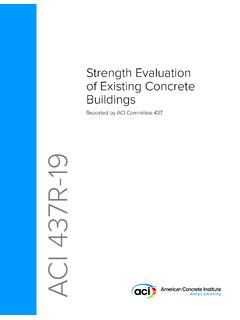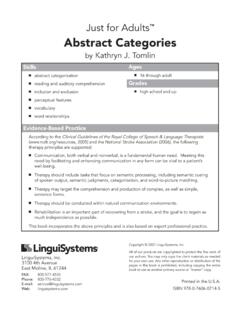Transcription of EN 13445 'Unfired pressure vessels'
1 EN 13445 "Unfired pressure vessels". Background to the rules in Part 3 Design Editors: Guy BAYLAC. Consultant and Technical Advisor to EPERC. 114 avenue F lix Faure F-75015 PARIS. Danielle KOPLEWICZ. Technical Director Union de Normalisation de la M canique F-92038 PARIS LA DEFENSE. Issue 2 20 August 2004. Introduction The European standard EN 13445 "Unfired pressure vessels" provides a precedent in that after 10 years of discussion between experts, a European consensus was achieved in the field of pressure equipment. Part 3 which was prepared by a group of leading European experts under the guidance of Dr. Fernando LIDONNICI, Sant'Ambrogio, (Milano, Italy), represents a major advance in European technical convergence.
2 The adoption of the first issue of EN 13445 in May 2002 was the first step of a continuous process for development & improvement. This new standard benefits from the contribution of all the European expertise; as such, it includes innovative capacities and supplies solutions for modern subjects. The CEN Design rules promote Limit Analysis and Design By Analysis Direct Route. Design has a strategic importance for the future and the competitiveness of the pressure equipment industry. Optimum design allows substantial advantages such as: thickness reduction and damage control in service with safety increase and drastic maintenance cost reduction. The objective of this book is to explain the background of these rules, to help industry to apply them in the most effective way.
3 It was initiated by EPERC, the European pressure Equipment Research Council, and and was awarded a contract of CEN, the European Standardization Committee, with support of the European Commission. The release of this booklet was made possible by the co-operative efforts of the experts involved in the discussion of Part 3, namely: - Guy BAYLAC Design criteria - Matteo CANNEROZZI Openings in shells - Joris DECOCK Additional non- pressure loads - Richard FAWCETT Shell under internal pressure , shell under external pressure , Design of flanges and domed ends - Alain HANDTSCHOEWERCKER Simplified assessment of fatigue life, Design by Analysis based on stress categories - Fernando LIDONNICI Flat ends - Stephen MADDOX Detailed assessment of fatigue life - Olavi VALTONEN Rectangular pressure vessels - Francis OSWEILLER Heat exchangers, Expansion bellows - Joachim WOELFEL Advanced design for flanges, Advanced design of tubesheets - Josef ZEMAN Design by Analysis Direct Route UNM, which leads the maintenance Help desk of EN 13445 (EN 13445 /MHD)
4 , provides its logistical support to compile and format the contributions, and agrees to put the booklet on the EN 13445 /MHD website for free uploading. 2 UNM 2004 All rights reserved Presentation This book shows the background to Part 3 "Design" of the European standard EN 13445 . "Unfired pressure vessels". To facilitate for the reader the cross-referencing between the explanations provided and the normative content of the standard itself, the booklet is organized according to the same clause numbering than the standard. In each clause, a different numbering, with letters, is provided. Each explanatory clause address the following topics: - Background and references to the rules (with, where relevant a bibliography included in each clause).
5 - Detailed description of the method and comparison to other methods - Future developments The following clauses are included: 1 Scope 2 Normative references 3 Terms and definitions 4 Symbols and abbreviations 5 Basic design criteria 6 Maximum allowed values of the nominal design stress for pressure parts 7 Shells under internal pressure 8 Shells under external pressure 9 Openings in shells 10 Flat ends 11 Flanges 12 Bolted domed ends 13 Heat Exchanger Tubesheets 14 Expansion bellows 15 pressure vessels of rectangular section 16 Additional non- pressure loads 17 Simplified assessment of fatigue life 3 UNM 2004 All rights reserved 18 Detailed assessment of fatigue life Annex A Design requirements for pressure bearing welds Annex B Design by Analysis - direct route Annex C Design by Analysis - method based on stress categories Annex
6 D Verification of the shape of vessels subject to external pressure Annex E Procedure for calculating the departure from the true circle of cylinders and cones Annex F Allowable external pressure for vessels outside circularity tolerance Annex G Alternative design rules for flanges and gasketed flange connections Annex H Table H-1 Gasket factors m and y Annex I Additional information on heat exchanger tubesheet design Annex J Alternative methods for the design of heat exchanger tubesheets Annex K Additional information on expansion bellows design Annex L Basis for design rules related to non- pressure loads Annex M Measures to be adopted in service Annex N Bibliography to Clause 18. Annex O Physical properties of steels Annex P Classification of weld details to be assessed using principal stresses Annex Q Simplified procedure for fatigue assessment of unwelded zones Annex ZA Clauses of this European Standard addressing essential requirements or other provisions of the EU Directives 4 UNM 2004 All rights reserved 1 Scope Part 3 of EN 13445 gives the rules to be used for design and calculation under internal and/or external pressure (as applicable) of pressure bearing components of pressure Vessels, such as shells of various shapes, flat walls, flanges, heat exchanger tubesheets, including the calculation of reinforcement of openings.
7 Rules are also given for components subject to local loads and to actions other than pressure . For all these components the DBF (Design by Formulae) method is generally followed, appropriate formulae are given in order to find stresses which have to be limited to safe values. These formulae are generally intended for predominantly non-cyclic loads, which means for a number of full pressure cycles not exceeding 500. However general prescriptions are also given for DBA (Design by Analysis) which can be used either to evaluate component designs or loading situations for which a DBF method is not provided, or, more generally, as an alternative to DBF. Methods are also given where a fatigue evaluation is required, due to a number of load cycles being greater than 500.
8 There are two alternative methods: a simplified method based on DBF (valid mainly in case of pressure variations) and a more sophisticated method based on a detailed determination of total stresses using, for example, FEM or experimental methods. This can be used also in the case of variable loads other than pressure . For certain components (such as flanges and tubesheets) also an alternative DBF method (based on limit analysis) has been provided; the choice of which method has to be used in each particular case is left to the Designer. For the time being, the scope of Part 3 is limited to steel components working at temperatures lower than the creep range of the specific material concerned. 2 Normative references Clause 2 includes the list of the referenced documents cited in EN 13445 -3 in such a way as to make them indispensable for the application of the standard.
9 These references are dated, that means that subsequent amendments to, or revisions of, dated references will need to be incorporated by amendment of the document referring to them. 3 Terms and definitions Clause 3 gives the definition of terms applicable to the whole Part 3 such as calculation pressure /temperature, design pressure /temperature, governing weld joint. Specific definitions are also found in the clause of the standard where they are used. 4 Symbols and abbreviations Clause 4 establishes symbols and units, needed to apply Part 3. Specific symbols are also found in the clause of the standard where they are used. The units are SI-units, consistent with the ISO 31 standard series. 5 Basic design criteria 5A General Basic design criteria for Part 3 are given in Clause 5.
10 It is essential to remember that: EN 13445 -3:2002 does not contain rules to design in the creep range. Creep design rules are under development and will be introduced later, probably in 2006. The rules are not applicable in case of localised corrosion. In this case the material shall be changed or adequate protection provided. 5 UNM 2004 All rights reserved Clause 5 deals successively with: Corrosion, erosion and protection Load cases Design methods Weld joint coefficient Design of welded joints 5B Corrosion, erosion and protection In the standard "corrosion" is a very general term to be understood as all forms of wastage. Thus, it is impossible to give rules to protect against corrosion, due to the multitude of cases to consider; only general advice can be provided in informative notes.







